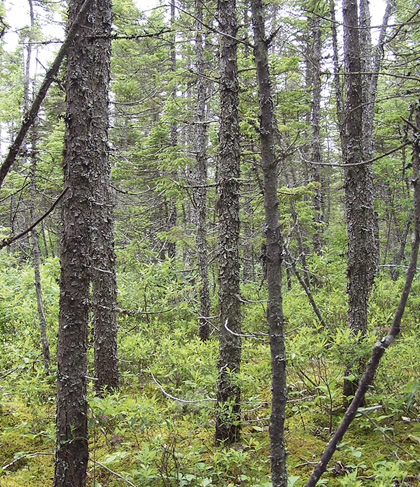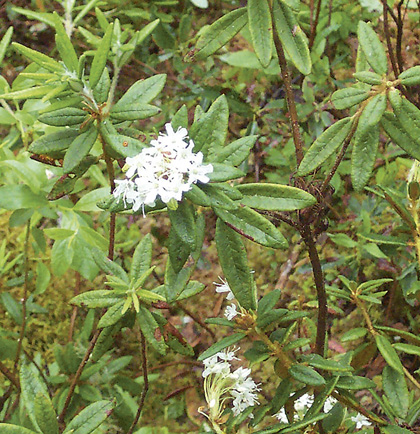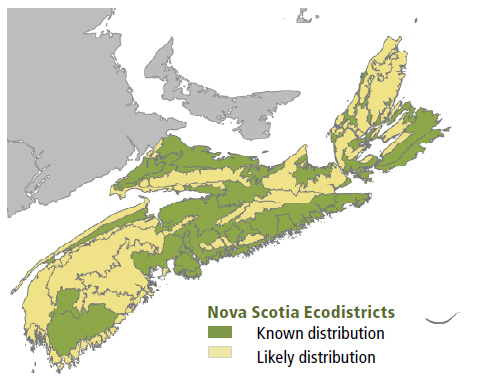
Forest Vegetation types - WC2
WC2 — Black spruce / Lambkill – Labrador tea / Sphagnum
Picea mariana / Kalmia angustifolia – Ledum groenlandicum / Sphagnum spp
WC2a — Huckleberry – Inkberry variant
Gaylussacia baccata – Ilex glabra
 |
| Black Lake, Cumberland County |
Concept: This nutrient poor to very poor coniferous forest is characterized by black spruce canopy dominance and by high shrub and sphagnum moss cover. It is found on poorly drained mineral or organic deposits, persisting as an edaphic climax. The ecosystem is the most acidic, wet black spruce forest in Nova Scotia. Stands with coastal plain species like inkberry and/or moderate to high levels of huckleberry distinguish the variant WC2a. WC2 is similar to WC1 (Black spruce / Cinnamon fern / Sphagnum), another wet black spruce forest with higher herbaceous cover and slightly less acidic soils.
Vegetation: Crown closure is low to moderate, increasing light availability to lower strata and promoting shrub abundance. The overstory is dominated by black spruce and/or hybrid black spruce-red spruce. In younger, more exposed, or extremely wet stands, the canopy may be formed by stunted trees in the tall shrub layer. The woody understory is thick with lambkill and scattered Labrador tea, rhodora and false holly. Creeping snowberry and goldthread characterize the sparse herbaceous layer. The dense bryophyte carpet is dominated by sphagnum moss. Ladies' tresses and flat topped sphagnum are common. Red fat-leaved sphagnum is much more frequent than in other coniferous wet forests of the province.
Environmental Setting: This ecosystem usually occurs on poorly drained flats, underlain by coarse textured glacial tills or peat. Some stands are found on imperfectly drained soil, but this is very uncommon. Ground and surface water flow is minimal and/or low in nutrients. Rooting potential is limited by compacted and/or saturated soils. Sites are moderately exposed, with very little microtopography. Sloped occurrences are usually found on the cooler aspects. Most stands are found in the Northumberland - Bras d'Or and Valley - Central Lowland ecoregions, but some extend into upland and even highland areas. Occurrences of WC2a are largely limited to the Western ecoregion. WC2 is widespread and abundant across the Maritime Provinces, but is particularly common in lowland regions.
Successional Dynamics: This forest is a type of edaphic climax, meaning it is maintained by limiting site conditions including soil saturation and shallow rooting potential. Tree windthrow and uprooting are common mechanisms of renewal, but fire and timber harvest can sometimes play a role. Most stands are mid-successional but this ecosystem can be expressed at a variety of successional stages. WC2 does not shift to other vegetation types after major disturbance, but does change in development stage. Uneven age class distributions are typically developed between these disturbances. Vegetative layering is the dominant form of black spruce regeneration.
Ecological Features: Crown closure in this small patch ecosystem is low to moderate, while the understory is thick with shrubs and regenerating trees. Plant species richness and site productivity is reduced, limiting habitat diversity and rare species potential. However, WC2a, the huckleberry-inkberry variant, occasionally supports somewhat rare Atlantic Coastal Plain plants like skunk cabbage, high-bush blueberry and Elliot's goldenrod. Similar to other wet forests, this wet forest can regulate water flow, provide filtration, and recharge groundwater. Reduced productivity and the presence of allelopathic plants (those that produce biochemicals that affect nearby plants) like lambkill can negatively influence black spruce regeneration and growth, resulting in lower canopy cover. These ecosystems provide thermal cover for moose and winter cover for deer. They can support numerous bird species, but specific associates are undocumented. These forests can sustain old growth conditions which are easily overlooked due to the generally small trees. It can support prominent levels of dwarf mistletoe and associated witches broom.
 |
| Labrador tea |
Distinguishing Features: Black spruce dominates this poorly drained softwood forest with a high shrub cover. The variant WC2a will have coastal plain species like inkberry and/or moderate to high levels of huckleberry. The herb layer is less developed than in WC1.
| Slope Position: | Level8 Lower1 Other1 |
Surface Stoniness: |
(Non - Slightly)8 (Moderately)1 (Very - Excessively)1 |
Bedrock Outcrop: |
(Non-rocky)10 |
Elevation Range: |
9 - 182m |
Slope Gradient: |
Level9 Gentle1 |
Aspect: |
East1 None8 Other1 |
Exposure: |
Moderate8 Mod. sheltered1 Other1 |
Microtopography: |
Level7 Slightly2 Moderately1 |
Drainage: |
Poor5 Very poor4 Imperfect1 |
Soil Type: |
ST44 ST143 ST72 Other1 |
Parent Material: |
Glacial till5 Organic3 Glaciofluvial1 Other1 |
Rooting Depth (cm): |
(<30)8 (30-45)1 nd1 |
Duff Thickness (cm): |
(6-10)1 (11-20)3 (21-40)3 (>40)2 nd1 |

